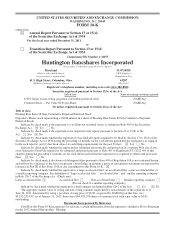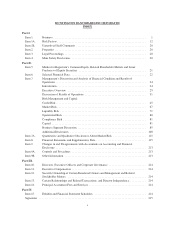Huntington National Bank 2011 Annual Report Download - page 19
Download and view the complete annual report
Please find page 19 of the 2011 Huntington National Bank annual report below. You can navigate through the pages in the report by either clicking on the pages listed below, or by using the keyword search tool below to find specific information within the annual report.In addition to the impact of federal and state regulation, the Bank and our nonbank subsidiaries are affected
significantly by the actions of the Federal Reserve as it attempts to control the money supply and credit
availability in order to influence the economy.
Our Tier 1 risk-based capital will be negatively impacted by the Collins Amendment provisions of the Dodd-
Frank Act.
The Collins Amendment provision of the Dodd-Frank Act imposes increased capital requirements in the
future. The Collins Amendment also requires federal banking regulators to establish minimum leverage and risk-
based capital requirements to apply to insured depository institutions, bank and thrift holding companies, and
systemically important nonbank financial companies. These capital requirements must not be less than the
Generally Applicable Risk Based Capital Requirements and the Generally Applicable Leverage Capital
Requirements as of July 21, 2010, and must not be quantitatively lower than the requirements that were in effect
for insured depository institution as of July 21, 2010. The Collins Amendment defines Generally Applicable Risk
Based Capital Requirements and Generally Applicable Leverage Capital Requirements to mean the risk-based
capital requirements and minimum ratios of Tier 1 risk-based capital to average total assets, respectively,
established by the appropriate federal banking agencies to apply to insured depository institutions under the
Prompt Corrective Action provisions, regardless of total consolidated asset size or foreign financial exposure.
Over a three year phase-out period beginning on January 1, 2013, trust preferred securities will no longer qualify
as Tier 1 risk-based capital for certain bank holding companies, including us. We have plans in place, including
the fourth quarter 2011 trust preferred securities redemption, to minimize the impact of this amendment on us.
Large bank holding companies are now required to submit annual capital plans to the Federal Reserve and
conduct stress tests.
The Federal Reserve published final amendments to Regulation Y to require large bank holding companies
to submit capital plans to the Federal Reserve on an annual basis and to require such bank holding companies to
obtain approval from the Federal Reserve under certain circumstances before making a capital distribution. This
rule applies to us and all other bank holding companies with $50 billion or more of total consolidated assets. The
first capital plans required under these rules were due on January 9, 2012. A large bank holding company’s
capital plan must include an assessment of the expected uses and sources of capital over at least the next nine
quarters, a detailed description of the entity’s process for assessing capital adequacy, the entity’s capital policy,
and a discussion of any expected changes to the banking holding company’s business plan that are likely to have
a material impact on the firm’s capital adequacy or liquidity. The Federal Reserve will either object to a capital
plan, in whole or in part, or provide a notice of non-objection by March 31, 2012, for plans submitted by the
January 9, 2012 submission date. If the Federal Reserve objects to a capital plan, the bank holding company may
not make any capital distribution other than those with respect to which the Federal Reserve has indicated its
non-objection. While we can give no assurances as to the outcome or specific interactions with the regulators, we
believe we have a strong capital position.
The Federal Reserve, FDIC, and OCC banking regulators issued proposed rules to implement section 165 of
the Dodd-Frank Act which requires financial institutions with total consolidated assets of more than $10 billion
(“covered banks”) to conduct certain stress tests on an annual basis. The Federal Reserve issued their final capital
plan rule in late 2011 and recently released proposed rules for the enhanced prudential standards requirements for
bank holding companies having assets of $50 billion or more. The OCC and FDIC have separately released their
proposed rules regarding annual stress tests. The Dodd-Frank Act requires these regulations to define the term
“stress test”; establish methodologies for the conduct of the stress tests that measure the Tier 1 common risk-
based capital ratio under at least three different sets of conditions, including baseline, adverse, and severely
adverse conditions; establish the form and content of a required regulatory report on the stress tests; and require
covered banks to publish a summary of the results of their stress tests. We submitted our capital plan to the
Federal Reserve in January 2012. We are currently evaluating the impacts to us under the OCC and FDIC
proposals and may need to file additional capital plans with these regulators.
5
























